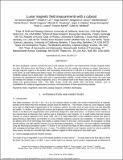| dc.contributor.author | Garrick-Bethell, Ian | |
| dc.contributor.author | Lin, Robert P. | |
| dc.contributor.author | Sanchez, Hugo | |
| dc.contributor.author | Jaroux, Belgacem A. | |
| dc.contributor.author | Bester, Manfred | |
| dc.contributor.author | Brown, Patrick | |
| dc.contributor.author | Cosgrove, Daniel | |
| dc.contributor.author | Dougherty, Michele K. | |
| dc.contributor.author | Halekas, Jasper S. | |
| dc.contributor.author | Hemingway, Doug | |
| dc.contributor.author | Lozano, Paulo C. | |
| dc.contributor.author | Martel, Francois | |
| dc.contributor.author | Whitlock, Caleb Wade | |
| dc.date.accessioned | 2013-10-23T12:32:55Z | |
| dc.date.available | 2013-10-23T12:32:55Z | |
| dc.date.issued | 2013-05 | |
| dc.identifier.issn | 0277-786X | |
| dc.identifier.uri | http://hdl.handle.net/1721.1/81473 | |
| dc.description.abstract | We have developed a mission concept that uses 3-unit cubesats to perform new measurements of lunar magnetic fields, less than 100 meters above the Moon’s surface. The mission calls for sending the cubesats on impact trajectories to strongly magnetic regions on the surface, and transmitting measurements in real-time to a nearby spacecraft, or directly to the Earth, up until milliseconds before impact. The cubesats and their instruments are partly based on the NSF-funded CINEMA cubesat now in Earth orbit. Two methods of reaching the Moon as a secondary payload are discussed: 1) After launching into geostationary transfer orbit with a communication satellite, a small mother-ship travels into lunar orbit and releases the cubesats on impact trajectories, and 2) The cubesats travel to the Moon using their own propulsion after release into geosynchronous orbit. This latter version would also enable other near-Earth missions, such as constellations for studying magnetospheric processes, and observations of close-approaching asteroids. | en_US |
| dc.language.iso | en_US | |
| dc.publisher | SPIE | en_US |
| dc.relation.isversionof | http://dx.doi.org/10.1117/12.2015666 | en_US |
| dc.rights | Creative Commons Attribution-Noncommercial-Share Alike 3.0 | en_US |
| dc.rights.uri | http://creativecommons.org/licenses/by-nc-sa/3.0/ | en_US |
| dc.source | SPIE | en_US |
| dc.title | Lunar magnetic field measurements with a cubesat | en_US |
| dc.type | Article | en_US |
| dc.identifier.citation | Garrick-Bethell, Ian, Robert P. Lin, Hugo Sanchez, Belgacem A. Jaroux, Manfred Bester, Patrick Brown, Daniel Cosgrove, et al. “Lunar magnetic field measurements with a cubesat.” In Sensors and Systems for Space Applications VI, edited by Khanh D. Pham, Joseph L. Cox, Richard T. Howard, and Genshe Chen, 873903-873903-26. SPIE - International Society for Optical Engineering, 2013. © 2013 Society of Photo-Optical Instrumentation Engineers (SPIE) | en_US |
| dc.contributor.department | Massachusetts Institute of Technology. Department of Aeronautics and Astronautics | en_US |
| dc.contributor.mitauthor | Lozano, Paulo C. | en_US |
| dc.contributor.mitauthor | Whitlock, Caleb Wade | en_US |
| dc.relation.journal | Proceedings of SPIE--the International Society for Optical Engineering | en_US |
| dc.eprint.version | Final published version | en_US |
| dc.type.uri | http://purl.org/eprint/type/ConferencePaper | en_US |
| eprint.status | http://purl.org/eprint/status/NonPeerReviewed | en_US |
| dspace.orderedauthors | Garrick-Bethell, Ian; Lin, Robert P.; Sanchez, Hugo; Jaroux, Belgacem A.; Bester, Manfred; Brown, Patrick; Cosgrove, Daniel; Dougherty, Michele K.; Halekas, Jasper S.; Hemingway, Doug; Lozano, Paulo C.; Martel, Francois; Whitlock, Caleb W. | en_US |
| dc.identifier.orcid | https://orcid.org/0000-0002-6063-3227 | |
| mit.license | PUBLISHER_POLICY | en_US |
| mit.metadata.status | Complete | |
